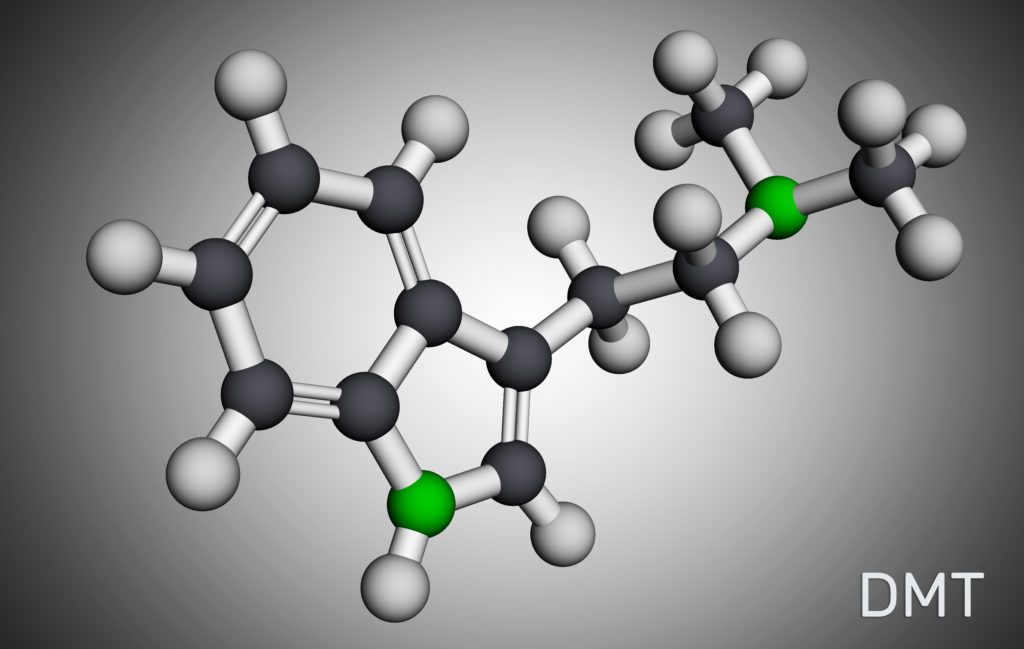
The subject of naturally occurring N,N-dimethyltryptamine (DMT) has fired up the imaginations of those interested in psychedelic science for decades. Endogenously produced DMT has been observed in organisms throughout the phylogenetic tree.1 While this is also true of compounds like psilocybin and mescaline, DMT goes a step further: it can be reliably detected in humans.2 Researchers have been studying the biosynthesis of DMT since the mid-20th century, and the story continues to unfold. All previous scholarship and research begs the question: does the human brain actually make DMT?
In 2019, a study from the University of Michigan examined the potential of the mammalian brain to synthesize DMT.3 DMT can be produced by a series of chemical manipulations of the dietary amino acid tryptophan.4 There are two key enzymes involved in reorienting tryptophan to DMT; aromatic-L-amino acid decarboxylase (AADC) and indolethylamine-N-methyltransferase (INMT).
Therefore, to address the question if the mammalian brain can/does produce DMT, Dean et al. looked at the concentration of INMT and AADC mRNA in cortical tissues. They did this using in situ hybridization, a molecular technique that allows for the detection of specific nucleotide sequences (DNA or RNA) in a given tissue sample.5 To quantify levels of DMT in rat brains, the team used fluorescence coupled with high-performance liquid chromatography (HPLC), a method they had previously used to quantify serotonin.6
This study reports for the first time that INMT mRNA is present in the pineal gland, cerebral cortex, and choroid plexus of both rats and humans. Perhaps the most remarkable finding from this study is the intracellular colocalization of both AADC and INMT mRNA in rat brains. However, it remains unclear whether the DMT detected using HPLC fluorescence detection is secreted from neurons and/or glial cells. Despite this, the expression of these two transcripts within the same neurons provides a plausible mechanism for DMT synthesis within mammalian brain tissue.
Another noteworthy observation discussed in this paper is that, in rats, neural DMT levels are significantly elevated following experimentally induced cardiac arrest. To examine the “pineal-based DMT secretion upon death” question, the group surgically removed the pineal glands of a subset of their rats. The increase in DMT was true whether the rats were intact or pineal-deficient. Moreover, DMT concentration for intact and pineal-deficient rats did not significantly differ following cardiac arrest. The authors remarked that this surge of DMT may be related to near-death experiences, citing a report which details commonalities of near-death experiences and subjective accounts from human subjects given DMT.7 Despite the general trends, not all rats demonstrated the spike in endogenous DMT following cardiac arrest. The writers go on to mention that less than 20% of cardiac arrest survivors report near-death experiences.8
While this study was not the first to find DMT present in the mammalian brain, it was the first to demonstrate colocalization of two key enzymes necessary for DMT biosynthesis within cells of the mammalian brain. The authors note that further work will need to be done to confirm that the DMT they’re detecting with fluorescence coupled HPLC is produced in the brain. They suggest an animal model with a brain-specific knockout of the Inmt gene. Subsequent analysis of neural-DMT concentration could potentially answer if the DMT found in the mammalian brain is, in fact, produced in the brain.
I remember when this study came out! It was really exciting. I was always a little skeptical of the idea that DMT exists in the brain and has a role in things like near-death experiences, because that explanation seemed a little TOO elegant. But maybe this will be one of those times when the elegant theory ends up being true. Except for the pineal gland bit, clearly! Can’t wait for more research on this to emerge.